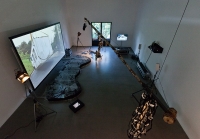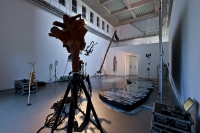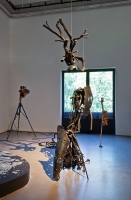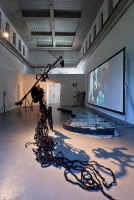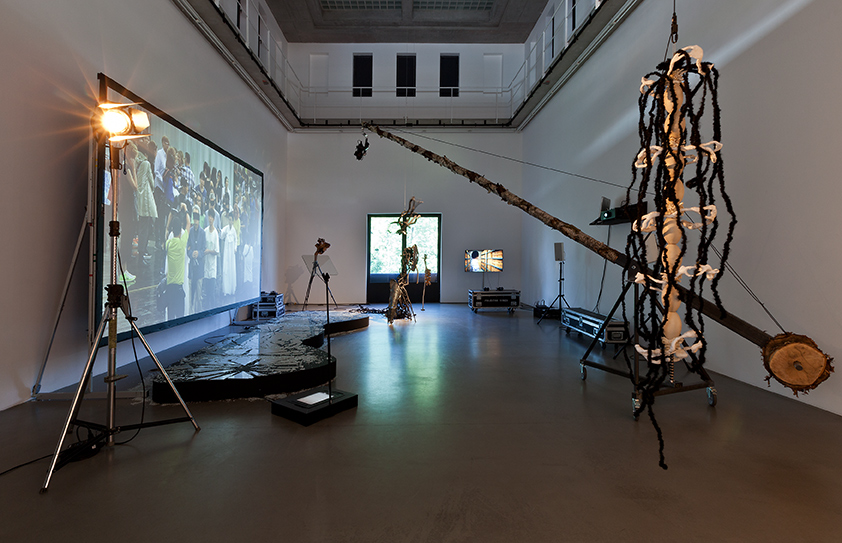
United Paradox installation view at Portikus, Frankfurt
Photos by Helena Schlichting.
Minouk Lim_United Paradox
14 May – 5 July 2015
Performance FireCliff 5
13 May, 7pm
임민욱 개인전 <역설의 연합체> 전시 요약글
<역설의 연합체> 전시는 또 하나의 방송국이다. 슬픔으로 유대하는 어떤 공동체를 보여준다. 흔히 사람들은 슬픔의 아픔을 가슴에 구멍이 뚫린 것 같다고 표현한다. 여기에서 임민욱은 관흉국 사람들 이야기를 연결한다.
관흉국이란 가슴에 구멍이 뚫린 사람들이 살고 있다는 중국 최초의 지리서에 나오는 나라이다. 작가는 동쪽에 있다는 그 나라가 슬픔으로 인해 통하는 역설적 공동체라고 말해왔다. 슬픔이 낸 구멍은 들어갈 수도 있고 나올 수도 있는 곳이라고 생각하기 때문이다. 그 구멍 너머에 타자의 얼굴이 있다.
그러나 구멍은 통로다. 그 통로에서 얼굴을 찾아 나서는 작가는 카메라, 스크린, 조명 스탠드 등을 뒤틀린 나무 뿌리와 같은 자연에 결합시킨 곳으로 관객을 초대한다. 이러한 조각적 설치는 미디어의 정의와 공동체의 범주를 질문한다.
헤어진 사람들은 어디에 살고 있고 이들은 누구인가. 이 가슴 속 구멍은 누구에게 말을 걸고 누구의 이야기를 전하는가. 작가는 분단국가의 현실이 사라지게 만든 몇몇 단어의 정의를 통해서도 묻는다. 국민과 인민, 친구와 동무는 어떻게 다른가, 어디에 있는가, 그 '감정'은 어떻게 다를까, 혹은 다르지 않을까.
이산과 실종된 삶을 이어가고 있는, 사회 속에서 가려진 존재들은 절반의 공동체라 부를 수 있을 것이다. 전시는 이 공동체를 추적하고 호출하려는 일종의 탐사보도 현장으로 꾸려지고 슬픔과 고통을 목격한 말없는 사물들은 ‘역설적 연합뉴스’를 전달한다.
공동체를 재현하는 것은 어떻게 가능할까. 미디어의 정보와 오브제에서 우리가 보는 것은, 혹은 볼 수 있는 것은 과거와 미래뿐이다. 이 역설은 공동체 바깥에 존재하는 사람들의 연합과 유대를 호출하려는 검은 안대처럼 정보의 추상성을 반올림한다. 나도 볼 수 없지만 너도 나를 볼 수 없다. 따라서 네가 나일 수도 있다. 검은 안대는 미디어의 모자이크처럼 양가적 의미를 지닌다. 그 익명성과 미지의 장소에 보고 싶어하는 마음으로 통일된 나라가 있다.
When war broke out in Korea in 1950, the South Korean government committed a series of massacres against the civilian population. Ordered by the leader of the South Korean government, Syngman Rhee, the mass murders were intended to annihilate those who were suspected of supporting the North or been accused of being traitors that had helped the Korean People’s Army. Even today, little is known about how and why these people died. Thirty years later, on May 18, 1980, people in Gwangju took to the streets to defend their country’s fledgling democracy. The newly installed military regime under Doohwan Chun slanderously portrayed the protesters as communists and commanded a massacre. Again, hundreds of people were killed and thousands wounded.
The work of South Korean artist Minouk Lim (b. 1968) explores these turning points in Korean political history: events that many prefer to forget and certainly do not wish to dwell on. Lim draws on historical and political reality to develop works including installations, sculptures, videos, and performance pieces that deal with South Korea and its capital, Seoul. The artist has devised a visual language designed to put the rapid growth and development that have remade the country’s face over the past decade on hold in order to initiate a process for which the German language has the peculiar word Vergangenheitsbewältigung: an effort to come to terms with the past.
The exhibition United Paradox is centered around Minouk Lim’s most recent work Navigation ID (2014), which addresses the abovementioned massacres and seeks to involve the victims’ surviving family members. An intervention and performance piece, Navigation ID was part of the 10th Gwangju Biennale Burning Down the House in 2014. On the day of the Biennale’s press opening, two freight containers were brought into the city from the other side of the country and set down on the Biennale square. They contained the bones of people who had died in the massacres of the 1950s; their families had painstakingly located and collected their mortal remains. The trucks carrying the containers were chaperoned by a bus with relatives and an ambulance; footage of the convoy’s “funeral march” shot from a helicopter and camera teams on the ground was broadcast live on a South Korean online news website. Portikus now presents the premiere of a video piece based on the performance. To emphasize the need for more reporting about the events after decades of virtual silence, the exhibition design is an abstract rendering of the setup of a television studio, complemented by sculptures and installation pieces.
In addressing a dark period in her own country’s past, Minouk Lim’s exhibition at Portikus reminds us that we refuse to face up to our history at our own peril. Germans know this only too well; we still struggle but have learned to examine and discuss our past publicly. Lim turns our attention to South Korea and a sensitive issue that the country’s swift rise to prosperity tends to obscure. The title succinctly expresses the contradiction at the heart of any community—a group of individuals who live together for a variety of reasons, not all voluntarily chosen, and share a past of suffering. United Paradox is an exhibition, a broadcasting studio as well as a starting point of a discussion on community building. Here, it presents a community united by an emotion of sorrow, expressed as the abstract feeling of a “hole in one’s chest.”
On the day of the opening, Minouk Lim will perform FireCliff 5, a new performance as part of the FireCliff series (2010–present). Presented as a “performance documentary theater,” the series delves into the artist’s continuing effort in grasping the sense of orientation within a society where the unforgettable is forgotten against the will of the many. FireCliff 5, a new rendition of the series in response to the exhibition at Portikus, appropriates the exhibition as a stage of the performance.
United Paradox, Minouk Lim’s first institutional solo exhibition in Europe, is produced in collaboration with Kunsthalle Wien, Vienna, where her work will be on view in the late fall 2015 as part of the group show Political Populism.
Director: Philippe Pirotte
Curator: Fabian Schöneich
